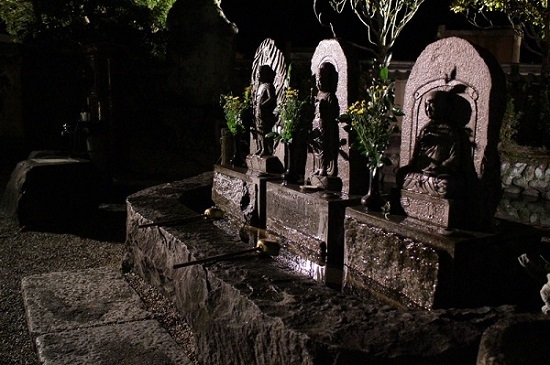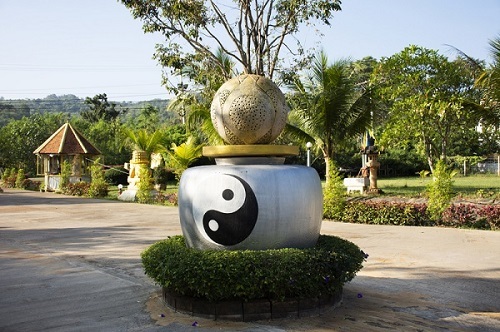

The Asuka Era was named for the city of the era, Asuka, which is today a region in the Nara Prefecture in the north. In 645 CE, the capital was moved to Naniwa, then during 694 as well as 710 CE, it was moved to Fujiwarakyo.
The Hakuho, as well as Asuka civilizations, simultaneously advanced throughout the Asuka Period, however the Asuka way of life accomplished so under Princess Suiko. Asuka, a village in the plains close to Nara, served as the nation's capital during the Asuka era, which spanned the years 538 to 710. The Kofun era, which preceded it and technically overlapped it, lasted from the middle of the 6th century to the outset of the 9th century.

Buddha Statue
Description: Holy Statues at Ashukadera Temple in Asuka
Ancient East Asia was ruled by the 3 states which are now know as Japan, China, and Korea. These kingdoms fought each other, exchanged ideas and traditions, exported crude ingredients and slightly elevated manufactured goods, and were involved in trade throughout history.
The Baekje monarchy established ties with Japan in a time during the Asuka Era on both an economic and cultural level. The subsequent decades saw a range of interactions between both Korea and Japan, from friendly commercial ties to outright conflict. Piracy became a significant problem because of massive fleets with occupying forces that raided deep towards Korean territories.
Chinese artistic and doctrinal influences began to slowly seep into Japanese society throughout the Asuka era. This imprint became even further during the Nura period as Buddhism expanded throughout Japan and also the Japanese strove to imitate the Chinese structure.
Chinese-influenced literature as well as music were ardently fostered by the court, while performers were given tax advantages. Numerous Buddhist sculptures were carved from wood as well as bronze.
A large part of how Baekje tradition got disseminated is via teachers, academics, and performers who also propagated Chinese cultural components overseas. Baekje missionaries may have brought Chinese lettering as well as Buddhism over Japan in the year 405 as well as 538, respectively. Its realism, realistic draperies, and anatomic clarity were all clearly influenced by Chinese art. Kukai, who journeyed to China but also mastered Chinese Buddhism as well as their penmanship and literature, is credited with establishing the Chinese governance in Buddhist thought and art.
It is thought that the Chinese 6 Kingdoms provided artistic inspiration for the Japanese Buddhist statuary of that kind of time. The manner of artworks from this era is also recognized as Tori Style in commemoration of very well artist Kuratsukuri Tori, the grandchild of Chinese immigrant Shiba Tatto.
It was a multilingual culture that was inspired by the Northern as well as Southern Aristocracies of China and brought to Japan either by Baekje or Goguryeo dynasties of Korea.
In the year 538, Buddhism and a new body of religious teaching were introduced to Japan by the Baekje monarch Seong.The Soga clan, a prominent Japanese court dynasty that came to power around 531 with the accession of the Ruler Kinmei, supported the implementation of Buddhism as well as Confucianist-based political and social ideas. The Nakatomi line, in charge of performing Shinto rituals at court, in addition to Mononobe, a warrior lineage, were keen about keeping their special rights, nevertheless, and they disapproved of Buddhism's particular theological effects.
Asuka-dera Temple as well as Shitenno-ji Temple did not become state-run temples, as proponents had hoped. The majority of the craftsmen who built Buddhist temples and sculptures in Japan were Korean immigrants and their offspring.
The Asuka Era was a time when Buddhism flourished in Japan. The previous age's tumulus-building operations were supplanted by temple as well as capital-building attempts. It was an era of new politics, the financial system, community, and policy changes. Japan transitioned from the old Yamato government as well as allied colonies to an Imperial units, so this era is regarded as the creation of such an ancient autocratic state.
During the time in power of Queen Suiko, the Asuka Civilizations principally in Yamato Domain. It commonly covered a period from the inauguration of Buddhism in natives of Japan throughout the Taika Reforms.
The imperial family as well as other elites stopped using grandiose kofun shrines as a result of the spread of emerging Buddhist teachings that placed a stronger emphasis on the impermanence of human existence.
The Asuka century also saw the introduction of Taoism. Taoist cosmology is also evident in the octagonal design of the emperors' cemeteries from this time period and, consequently, the celestial graphs shown in the Kitora as well as Takamatsuzuka kofun.
In the conclusion, Taoist precepts were combined with Buddhist, Shint, as well as other religious practises to generate new types of rituals. One result of such religious crossovers is onmyde, a form of Japanese cosmology as well as geomancy.

Symbol of Taosim
Religious squabbles among clans actually started the Asuka time frame, but as time passed, imported religions as well as Japan's native folk perceptions merged.
Q1. What religious practice does Asuka practise?
Ans. The Asuka timeframe, labelled well after region close Nara in which the court lived, corresponds with the initialisation of Buddhism in and out of Japan. Many ideas as well as images in this new faith were completely contradictory to native Shinto considerations.
Q2. Describe the architectural significance during Asuka's dominance.
Ans. The Asuka era's temple decor was significantly influenced by Chinese architectural style. Chinese-style monuments were extraordinarily complex in respect of work and décor, in contrast to the simple conception and building of Shinto shrines.
Q3. Which clan was incredibly strong during the reign of Asuka?
Ans. The Soga clan was a mighty patrician kin group during the Asuka empire in the early Japanese state—the Yamato polity—and was instrumental in the spread of Buddhism.